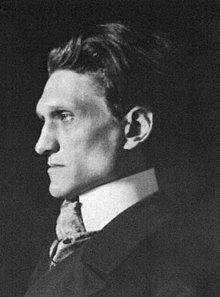Leaves for art



Blätter für die Kunst was a literary magazine founded by Stefan George in 1892 and edited by Carl August Klein . At first she pursued the aesthetic program of an “art for art” ( l'art pour l'art ), which she wanted to convey to a deliberately limited readership.
The sheets appeared in private printing until 1919 (ie in the so-called Verlag der Blätter für die Kunst, printed by Otto von Holten ) at irregular intervals with a total of twelve sets of five booklets each with 32 pages, some of them as double editions. The edition increased from an initial 100 to 2000 copies. The first editions were only available in three selected bookshops in Berlin, Vienna and Paris. Until its end, the magazine was the central publication organ for Stefan Georges and his friends.
Already since the first edition in 1892 the exclusivity was emphasized on the title page with the sentence “This magazine published by the publisher has a closed readership, invited by the members.” George succeeded shortly after the foundation, some - mostly still unknown - contemporary poets to win for the magazine. The greatest literary weight, alongside George's contributions, were those of Hugo von Hofmannsthal , who, however, had a difficult relationship with George. Other collaborators in the early days were poets like Richard Perls , whose works were hardly widely distributed and are now forgotten. George also got to know foreign poets such as the Belgian Paul Gérardy , the Dutch Albert Verwey and the Polish Wacław Rolicz songs , which subsequently also published in the papers . In literary terms, the magazine in the 1890s was mostly oriented towards French symbolism and its understanding of art as an autonomous space (l'art pour l'art). With Melchior Lechter , who designed the publications of the sheets as a book artist, and above all Karl Wolfskehl , the magazine finally got further important supports, especially since Hofmannsthal increasingly withdrew. Publicists and intellectuals such as Oscar AH Schmitz or Ludwig Klages published in the papers . Through Klages and Wolfskehl, the magazine also became a literary mouthpiece for the Munich Cosmiker Circle around 1900 .
George's acquaintance with Friedrich Gundolf in 1899, the death of Maximilian Kronberger in 1904 and the so-called "Cosmiker Crisis" around 1903 marked a turning point in the history of prints for art. These events mark the transition of a relatively loose circle of poets around George and the prints to George -Circle from the "master" mostly unconditionally devoted disciples.
The sheets now became the literary-intellectual mouthpiece of the circle, important circle writings like Friedrich Wolters ' Herrschaft und Dienst mostly appeared there first. With the 9th episode of 1910, there was a pause, which was initially bridged from 1910 to 1912 by the yearbook for intellectual movement . During the First World War, no sheets for art were published either ; the last series was published in 1919.
Circle of leaves for art
Everyone who purchased the magazine and was noted on a list for this purpose was assigned to the “circle of sheets for art”. An active contribution was not connected with the “membership” in this circle. It included members from the USA, Germany, England, France, the Netherlands, Italy, Japan, Austria, Romania, Switzerland, Turkey and Hungary, including 33 women.
Known members were:
- Germany: Max Dessoir , Louise Dumont , Karl von Großheim , Max Herrmann , Bess Brenck-Kalischer , Marianne Plehn , Oskar Walzel , August Endell , Georg Swarzenski , Conrad Ansorge , Reinhold Lepsius , Georg Simmel , Berthold Litzmann , Ferdinand Avenarius , Heinrich Simon , Botho Graef , Oskar Kohnstamm , Elsa Asenijeff , Max Klinger , Emil Geyer , Karl Bauer , Walter Braunfels , Hugo Bruckmann , Franz Dülberg , Friedrich von der Leyen , Arthur Salz , Karl Wolfskehl , Kurt Breysig , Ludwig von Hofmann , Ernst Hardt , Ludwig Thormaehlen
- France: Charles Du Bos
- Netherlands: Jan Toorop , Albert Verwey
- Poland: Wacław Rolicz songs
- Austria: Richard Beer-Hofmann , Hugo von Hofmannsthal , Josef Redlich , Richard von Schaukal , Wilhelm von Wymetal
- Romania: Dimitrie Alexandru Sturdza
- Switzerland: Robert Boehringer , Karl Joël , Richard Mondt
literature
- Karlhans Kluncker: Sheets for Art. Magazine of the poet school Stefan Georges. Dissertation. Technical University Aachen 1973. Klostermann, Frankfurt am Main 1974. (Studies on Philosophy and Literature of the Nineteenth Century, Volume 24.)
Web links
Remarks
- ↑ See the list in: Stefan George. Documents of its effect . Edited from the Friedrich Gundolf Archive of the University of London by Lothar Helbing and Claus Victor Bock with Karlhans Kluncker. Castrum Peregrini Presse, Amsterdam 1974.